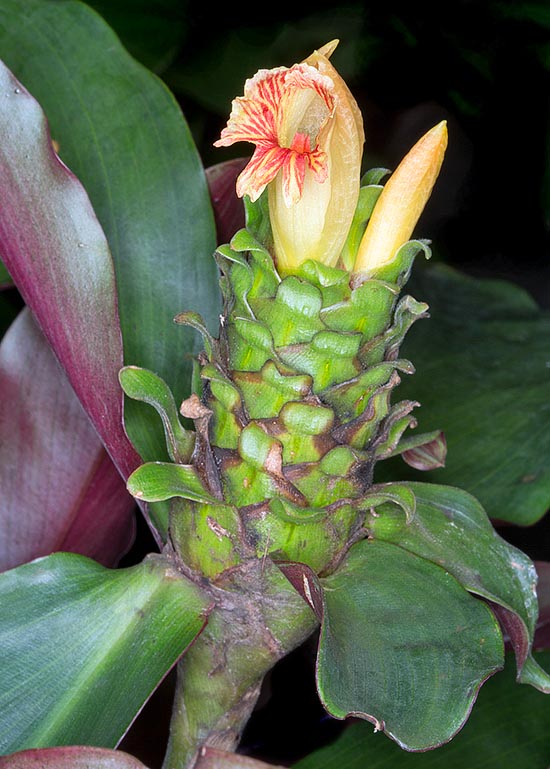Family : Costaceae

Text © Pietro Puccio

English translation by Mario Beltramini

At home in Brazil, with horticultural future, Costus varzearum has been described only in 1976 © Giuseppe Mazza
The generic name was given by Linnaeus in deference to Dioscorides who had described a plant, deemed similar, with the name of Kostos; the specific Latin name refers to the local name of the ecosystem where it lives.
Common names: blood red spiral costus, burgundy leaf ginger, oxblood ginger (English); caña caña (Spanish).
The Costus varzearum Maas (1976) is an evergreen, perennial rhizomatous herbaceous species, 0,4-1,2 m tall, with cylindrical stems covered by foliar sheaths of green colour shaded purple. The leaves are alternate, simple, entire, elliptic to obovate with long pointed apex, 8-25 cm long and 5-10 cm broad, coriaceous, slightly wavy, of glossy dark green above, purple below.
The inflorescence is an ovoid terminal spike, 4-7 cm long and of 3-4 cm of diameter, formed by ovate imbricate bracts, 2-2,5 cm long and 1-1,8 cm broad, coriaceous, with foliaceous appendage at the extremity, 0,5-1,5 cm long, curved outwards, of green colour. The hermaphroditic flowers emerging from the bracts have a campanulate calyx, about 1 cm long, with three almost triangular lobes, of reddish colour, tubular 4,5-5,5 long corolla with three oblong lobes with yellow or pink flattened apex, about 1,5 cm broad, fertile cream stamen with red apex, about 3 cm long, and ovate labellum with curved central lobe, 4-5 cm long and 3-4 cm broad, of yellow streaked with red colour. The fruits are ovoid capsules containing blackish seeds provided of aril.
It reproduces by seed, in loam rich of humus with addition of sand or perlite per a 30% maintained humid at the temperature of 24-26 °C, by division in spring and through the plantules produced at times on the old inflorescences.
Vigorous species and of easy cultivation with particularly ornamental foliage cultivable in the tropical and humid subtropical climate regions, its cultivation may be tried in the warm-temperate ones, where it behaves as deciduous, being able to resist at the rhizome level to temperatures of some degree under 0 °C if placed in sheltered location and dry to avoid rottenness. Due to the reduced dimensions, it may be utilized for edges or as soil cover also in gardens of limited extension. It requires a slightly shaded exposition, but can bear some hours of direct sun in the morning, and well drained soils rich of organic substance, slightly acidic to neutral, maintained constantly humid.
Successfully cultivable also in pot for the decoration of open spaces as well as of luminous interiors, in the coldest climates, with winter lowest night temperatures not under the 14 °C; useful are the nebulizations, in presence of high temperatures and of dry air, to be done with non calcareous water to avoid antiaesthetic spots on the leaves. During the vegetative period the waterings must be regular and abundant, more reduced in winter, allowing the substratum to dry up almost completely before watering again in presence of low temperatures; the fertilizations are to be done in spring-summer with hydrosoluble balanced products with microelements under forms of chelates at half the dosage suggested by the producer.
→ To appreciate the biodiversity within the family COSTACEAE please click here.
